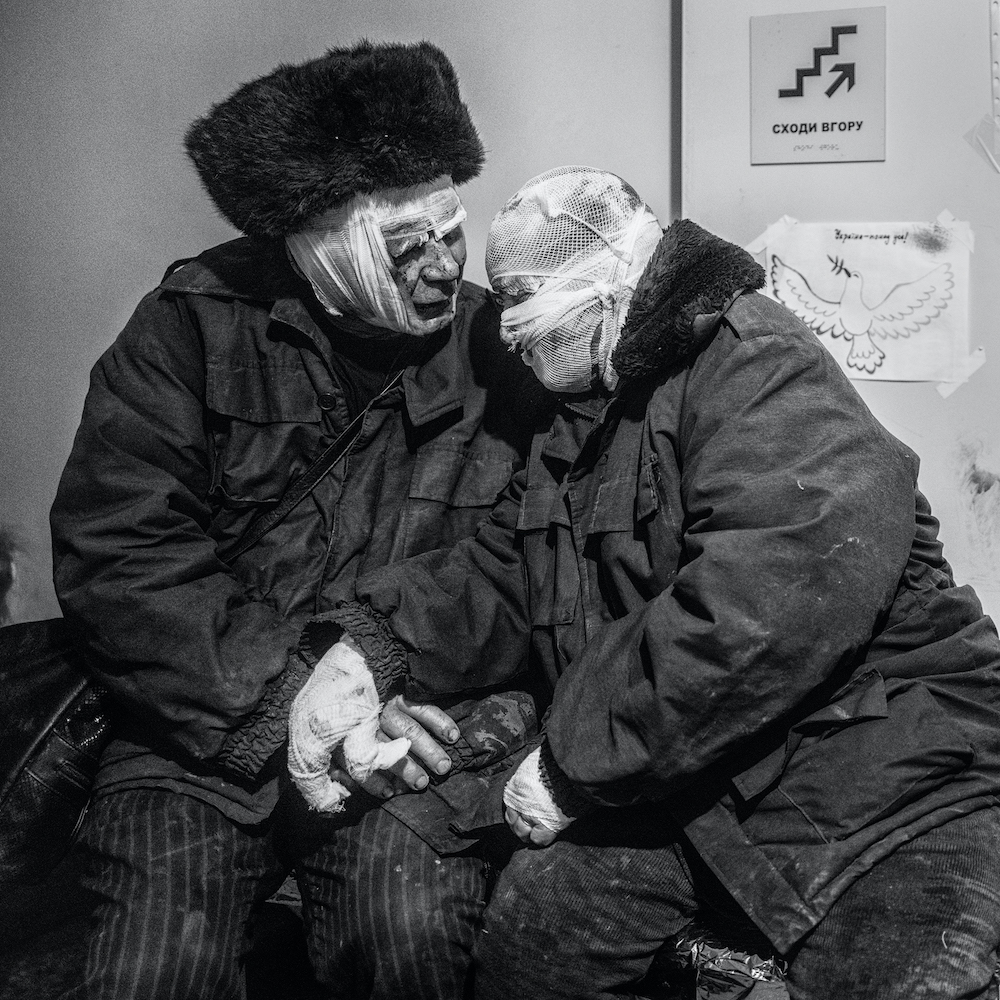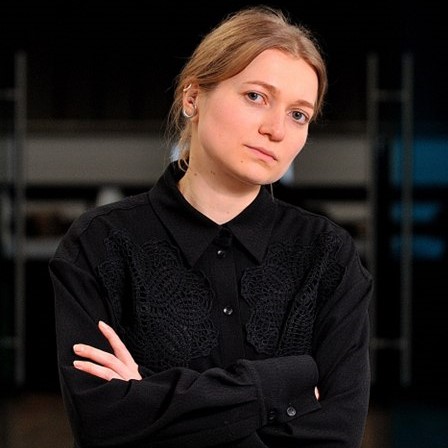Bakhmut, November 17, 2022. A photograph by Eddy van Wessel

In November 2022, Dutch photographer Eddy van Wessel took a picture in a Bakhmut hospital: an elderly couple comforts each other after a Russian missile has destroyed their home. They are Volodymyr Rakitsky and Lidia Rakitska, who have come under fire in their hometown of Chasiv Yar. The house they lived in for over 45 years has burned to the ground with all of their belongings.
When the photo appeared, I saw it being compared to Magritte’s painting The Lovers (1928) in my feed. The comparison was of the formal aspects of both images – the taste of a kiss forever out of reach. The faces in the photograph are bandaged because of their burns, but some things can still be made out: her eyes are closed, his eyes are looking at her, their bodies are turned toward one another, they’re holding each other tenderly by the hand (though really just touching, since they’ve suffered burns to their hands as well). Their proximity, the contact between their bodies’ burned tissues are painful. There is so much pain in this portrait.
But there’s something else, too. The surrealism of war comes through in the print-out of the dove of peace hanging on the wall behind the woman. This dove of peace reminds the viewer that the war is real and it is very close. And it has real consequences that affect real people: their lives are not metaphorical; their flesh is devoid of metaphors. Their understanding of war and peace is clearly based on something real – on experience. It doesn’t seem fitting to call this couple “lovers” à la Magritte since this is a different kind of love, love in joy and in grief. And in the face of war.
This phrase, “in the face of war” is on the one hand a metaphor for horror, and on the other hand about the ability to look at this horror and perceive it. Visual criticism and war journalism don’t always celebrate close-ups that convey and aestheticize the suffering of others. For example, in her article Close-Up of Death, first published in 1992, journalist Slavenka Drakulić concludes: “The feeling that for the first time it is possible to watch war from so near in its most macabre details, makes sense only if, because of that, something can change for the better. But nothing changes. Therefore, this kind of documentation is turning into a perversion, into a pornography of dying.” Drakulić describes in detail how the media reported on the sudden death of a two-and-a-half-year-old girl over a Ramadan breakfast. The blood was not yet dry, Drakulić points out: the bright stain tells us that the tragedy happened almost right in front of our eyes.
When someone stands in the face of war, who is looking at whom: the person at war, or war at the person? What’s hidden in their gazes?
I’m writing this in 2025, staring at the details of another war – my war. Here we also have plenty of discussions about close-ups of suffering, torture, and death: about the ethics of these images, about the sense and purpose of documenting and publicizing these scenes. Why is our society having these conversations again? Perhaps we create and reproduce pain when we’re searching for our own visual language, which is really not a new language at all but merely an attempt to scream – despair? I have no answer to this question, at least not now in the middle of this war. Maybe I won’t be able to find one afterwards either. Or maybe no answer is needed.
This question, the question about the gaze, is born of horror. Likely, it is horror that contains the answer as well.
I see how horror pushes people away: not only in documentary footage of war, but in art too, where death and torture are qualified, where death is an image. In the late 1940s, Francis Bacon’s works evoked horror in a London stunned by war. This was a pivotal time for the artist, when he made the paintings that would become central to his oeuvre – the human figure and the faceless screaming head. In works from his Head cycle, the technique he used to create extremely voluminous, heavy layers of paint is also interesting. “Francis Bacon saw the body as a discrete entity, and as meat,” the Bacon estate explains. His paintings were the same – full of flesh.
Bacon was once asked in an interview what the scream meant. He responded, “We are born with a scream; we come into life with a scream, and maybe love is a mosquito net between the fear of living and the fear of death. That was one of my real obsessions. The men I painted were all in extreme situations, and the scream is a transcription of their pain. Animals scream when they are frightened or in pain, so do children. But men are more discreet and more inhibited. They do not cry or scream except in situations of extreme pain. We come into this world with a scream and we often also die with a scream. Perhaps the scream is the most direct symbol of the human condition.”
Because of asthma, Bacon was deemed unfit for military service during World War II, but he volunteered for the civil defense and ended up working in the rescue service. His job was to put out fires, save civilians, and search for the dead. Bacon was in London during the Blitz, and saw maimed and torn-up bodies. The flayed bodies, the scream in his work – these are the direct result of war and of his personal experience witnessing violence that pierces the flesh, gets under the skin. This is the scream of the strongest. A scream without a scream.
What does Bacon’s work have to do with any of this? When I look at the photograph of the two elderly people whose bodies and faces are covered in burns, I realize that it would be nearly impossible to scream here. Screaming can also cause pain, not just the other way around. “We’re so glad to have survived this horror. Thank you so much for the money, but we want you to leave us alone,” the subjects of his photograph told Eddy van Wessel sometime after his photo had begun drawing attention to them. “How else should people their age feel?” their grandson, Oleksandr Pedchenko, asked in an interview with Vilne radio. “They don’t really like publicity. Grandma was shocked. I’ve already explained to her that the whole world has seen them. You can’t stop that; you just have to accept it.”
They don’t need a scream; they need comfort and quiet.
As I wrote this, I was thinking about the fragile link between sympathy and horror, about what makes people depict, capture, and broadcast images of horror and shock. Grief, suffering, and horror demand context; they demand names and biographies. War takes away the privacy not only of torturers and killers, but of the people caught up in hardship and suffering. There are no wars without global consequences, but this is not the extent of the horror – the horror lies also in the extraordinary intimacy of war’s effects, which cut into the experiences and relationships we have gained and lived through. Even when we try to approach an understanding of someone else’s pain, we are not capable of fully grasping it. We remain captive to the image demanding a reaction from us – be it sympathy or an urge to turn away. But we should not turn away. Ever.
The surrealism movement that Magritte was part of was established in Paris in 1924 in between wars. It was essentially the result of World War I and an attempt to escape it, but it was unable to save the world from the next war. All art is helpless in this regard. But where does art’s power lie? Precisely in the images that evoke emotions, elicit empathy and sympathy; that force people to think about what is happening in the world around them, and to see their own place in it.
Even with the understanding that it isn’t possible to feel what someone else has experienced, we should try to come as close as we can – yet stay far enough away so as not to wound or cause pain. This doesn’t mean turning away, deeming horror inconvenient, or distancing ourselves from others and their tragedies. Rather, it means accepting and understanding that there are different kinds of pain and trauma; recognizing the reality of all-pervasive pain.
Translated from Ukrainian by Ali Kinsella.
Copy-edited by Katharine Quinn-Judge.
